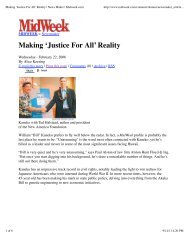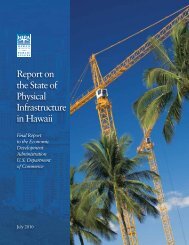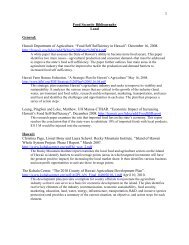Hawai'i Fisheries Initiative - The Hawaii Institute for Public Affairs
Hawai'i Fisheries Initiative - The Hawaii Institute for Public Affairs
Hawai'i Fisheries Initiative - The Hawaii Institute for Public Affairs
Create successful ePaper yourself
Turn your PDF publications into a flip-book with our unique Google optimized e-Paper software.
Native <strong>Hawaii</strong>an<br />
<strong>Fisheries</strong><br />
Management<br />
Native <strong>Hawaii</strong>an Ahupua‘a: <strong>The</strong> original<br />
ecosystem management system<br />
As expressed in the creation chant,<br />
Kumulipo, Native <strong>Hawaii</strong>ans view the earth<br />
and ocean as living entities. Rather than<br />
being separate and distinct, <strong>Hawaii</strong>ans<br />
consider themselves physically and<br />
spiritually related to the ocean and its<br />
inhabitants. 489 This differs sharply from the<br />
Western view of ocean management, which<br />
largely views the ocean as a source of food<br />
and wealth <strong>for</strong> human exploitation.<br />
<strong>The</strong> <strong>Hawaii</strong>an concept of deep connection<br />
to the marine environment is in keeping<br />
with the traditions of other native peoples<br />
throughout the Pacific. <strong>The</strong> Maori of<br />
Aotearoa, or New Zealand, developed a<br />
law of the sea:<br />
First, that the sea is part of a global<br />
environment in which all parts are<br />
interlinked. Second, the sea, as one of<br />
the taonga or treasures of Mother Earth,<br />
must be nurtured and protected. Third,<br />
the protected sea is a koha or gift which<br />
humans may use. Fourth, that use is to<br />
be controlled in a way that will sustain<br />
its bounty. <strong>The</strong>se principles still guide<br />
the Maori, and they have drawn on<br />
them in their recent claims be<strong>for</strong>e the<br />
Waitangi Tribunal to protest, <strong>for</strong> instance,<br />
against sewage discharges into the rivers,<br />
lakes, and estuaries that are part of<br />
their natural environment. <strong>The</strong> Maori<br />
perspective is that pollution should not<br />
be attacked ‘by seeking more effective<br />
methods of waste disposal as is often<br />
advocated today, but by ensuring that<br />
any activity produces as little waste as<br />
possible at its source.’ 490<br />
Native <strong>Hawaii</strong>ans had an intricate system<br />
vof land and ocean management based<br />
around geographic designations called<br />
ahupua‘a, generally wedge-shaped areas<br />
that ran from the mountains to the sea,<br />
often spanning from one ridge-line to the<br />
next and encompassing the valley and<br />
rivers in between. 491 Under the authority<br />
of the konohiki (an administrator or lesser<br />
chief, given his authority by the ali‘i nui,<br />
or the high chief of the island), the maka‘a –<br />
inana (commoners, tenants) of the ahupua‘a<br />
had the exclusive rights to fish in the<br />
adjacent coastal waters. 492 Fishponds were<br />
constructed on the coasts to supplement<br />
the wild seafood harvests used to benefit<br />
the ahupua‘a tenants, the konohiki,<br />
98







